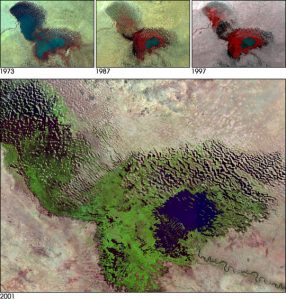Although much of its landscape is arid, Somalia normally has two rainy seasons a year. So for generations, Somalia’s pastoral community has survived by herding their animals to wherever the rain has collected into puddles and streams.
Now, though, John Watkin of the Critical Ecosystems Partnership Fund says Somalia is suffering its worst drought in decades.
“This is now the worst drought in 60 years and the worst famine in 20 years. This is because of a series of years where we’ve had a failure of the rains – either one or both rains each year. So that has resulted in there being no resilience whatsoever in the natural resource base. But these artifacts are of larger global trends which are significant deforestation all around the world which means that we don’t have the forest which secure the water.”
Forests help conserve water when it does rain, and play a major role in the water cycle through a process call transpiration (water in the leaves of trees is discharged back into the atmosphere). According to the U.S. Geological Survey, a large oak tree can transpire 151,000 liters of H2O per year. The roots of trees and shrubs also help retain soil and prevent environmental degradation (such as desertification).
But forests across the globe have been shrinking, including in Africa, where the U.N. Food and Agriculture Organization estimates more than 30 million hectares of forest have been lost in the past decade. Worldwide – there has been a net loss of more than five million hectares of forest a year, mostly due to human activity.
Bob Winterbottom at World Resources Institute says drought is part of natural ecosystems. But increasingly, he says, human activity like logging, agriculture and greenhouse gas emissions are interfering with ecosystems. Therefore, he says, there needs to be better management of natural resources.
“So that we can build a base for sustainable development, so when rains are restored, that they do the maximum amount of benefit for people as opposed to damage.”
Deforestation isn’t just a problem for Africa, it can affect climates and eco-systems all over the world. So while the immediate focus must be on Somalia’s famine, both Winterbottom and Watkin say in the long term, the international community needs to address the underlying environmental issues that may have led to the humanitarian disaster.
More than 11 million people in the Horn of Africa have been affected by the drought and subsequent famine.






 “E-15. We were able to break through that wall with the EPA this year, so we hope E-15 will be available throughout. But some of the mid-level blends like E-30 as an example is something that still gives the power and kind of octane, fuel mileage, etc. that many of our consumers want. And at the same time allows them to save on price at the pump by putting in something that’s cheaper and home grown like ethanol as opposed to foreign oil such as gasoline.”
“E-15. We were able to break through that wall with the EPA this year, so we hope E-15 will be available throughout. But some of the mid-level blends like E-30 as an example is something that still gives the power and kind of octane, fuel mileage, etc. that many of our consumers want. And at the same time allows them to save on price at the pump by putting in something that’s cheaper and home grown like ethanol as opposed to foreign oil such as gasoline.”





 The bodies of the husband and wife team were found at the Praialta-Piranheira nature reserve, where they had been working for the past 24 years. Their commitment to protecting the world’s largest rainforest put them at odds with commercial loggers, ranchers and farmers. The environmentalists had previously reported threats to their lives.
The bodies of the husband and wife team were found at the Praialta-Piranheira nature reserve, where they had been working for the past 24 years. Their commitment to protecting the world’s largest rainforest put them at odds with commercial loggers, ranchers and farmers. The environmentalists had previously reported threats to their lives.


 The song commemorates a 1927 incident in which the levee downstream from New Orleans was dynamited to keep water from inundating the city. So, instead of the city, it swallowed up some smaller, poorer communities in St. Bernard and Plaquemines Parishes.
The song commemorates a 1927 incident in which the levee downstream from New Orleans was dynamited to keep water from inundating the city. So, instead of the city, it swallowed up some smaller, poorer communities in St. Bernard and Plaquemines Parishes.

